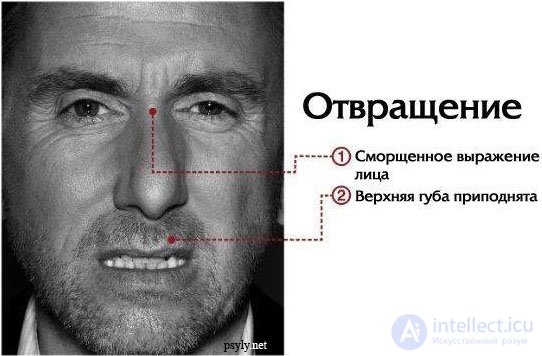
Experience of disgust
Disgust is a manifestation of deep hostility. The taste of something that you want to spit out immediately, or even just the thought of having to eat something like that can make you disgusted. The smell that makes you pinch your nose also makes you disgusted. You can even become disgusted by the very thought of how disgusting such a smell is. You may be disgusted by the appearance of something. You may be disgusted by sounds if they are associated with an event that you hate. Also, the touch of something opposite, for example, slippery or gelatinous, can cause a feeling of disgust.
Tastes, smells, touches that you may consider unpleasant for yourself will not necessarily be unpleasant for everyone. What is repulsive to people of one culture may be attractive to people of another. The easiest way to illustrate this thesis is through food: dog meat, bull testicles, raw fish, and raw calf brains do not seem appetizing to many people. Even within one culture there is no consensus about what is considered disgusting. In our society, someone likes to eat raw oysters, and someone can not stand even this one spectacle. Disagreements can also exist in the family: children often “hate it” some products that later find it very tasty.
Aversion usually involves the manifestation of repulsion and evasion reactions, the purpose of which is to remove an object from an individual or to evade an individual from contact with an object. In the case of manifestations of the most extreme, primitive and uncontrollable aversion, a person develops nausea and vomiting. Such a reaction can be caused not only by a disgusting taste, but also by a disgusting smell or appearance. Of course, nausea and vomiting can occur in the absence of disgust, and disgust can occur without nausea and vomiting.
Not only tastes, smells, touches, visual images or sounds can cause disgust, but also the actions and appearance of people or even their ideas. It happens that people have a disgusting appearance. There are people who are disgusted by the sight of a cripple or a person with an ugly appearance. Disgusting can be caused by a person injured in an accident with multiple open wounds. The sight of the blood or the work of the surgeon performing the operation also causes disgust in some people. There are repulsive actions of people. A person who tortures his dog or cat may be disgusting to his neighbors. Disgust can cause a person to do what others call sexual perversions. A life philosophy or way of treating people degrading to human dignity can also cause disgust.
Aversion can vary in intensity - from aversion, causing nausea and vomiting, to moderate hostility, causing a desire to avoid any contact with the object of antipathy. In the event of a moderate dislike, repulsive or evasive impulses may or may not be restrained by actual action, but antipathy towards the source of aversion will still be felt. You can demonstrate a moderate reaction of disgust at the smell of a new dish, which you are treated to, but still find the strength to swallow at least a piece. The person from whom the unpleasant smell emanates may cause you to experience a slight feeling of disgust; you don't like contacting him, but you can give him a hand. When you hear how your friend punishes your child, you can also experience a slight feeling of disgust if you don’t approve of such upbringing methods, but your friendship can withstand such an ordeal, and you continue to maintain the same relationship with that person.
Contempt is akin to disgust in many ways, but it also has its differences. Contempt can only be felt towards people or their actions, but not towards tastes, smells or touches. Stepping on dog excrement, you may experience disgust, but not contempt; the idea of eating raw calf brains can also cause disgust, but not contempt. However, you can scornfully treat people who eat such unappetizing products, because in contempt there is an element of condescension towards those who cause this contempt. Showing in your dislike of people and their actions an element of neglect, you feel your superiority (usually moral) towards them. Their behavior is disgusting, but you feel disdain for them and do not necessarily break off relations with them. Mockery is a type of expression of contempt that allows you to make fun of a person for his faults and shortcomings; usually it contains a portion of caustic humor, which gives pleasure to the one who scoffs, and suffering - to the object of ridicule.
Often, disgust and contempt are experienced simultaneously with anger. You may be angry with someone for disgusting you. For example, if a husband drank too much at a party and began to behave indecently, then the wife may experience disgust and anger; while her anger will be caused by the behavior of her husband causing the general aversion. Or if some person commits lecherous actions against a child, the sexual act itself may cause disgust, and anger is caused by the immorality of such an act. If someone’s actions cause you more disgust than anger, then this usually happens because they do not pose a threat to you - you just turn away from this person and not try to defend yourself or attack him. Often, disgust is used to disguise anger, because in certain groups of society there is a taboo on anger. Paradoxically, some people prefer to provoke anger rather than disgust. If you disgust, then your offense is perceived as disgusting. Whether you prefer to cause disgust or anger depends on the intensity of these feelings and on whether they are viewed as directed at a specific action or personally towards you.
Disgust can be mixed not only with anger, but also with surprise, fear, sadness and joy. Here we discuss and show each of these reactions. People may enjoy the disgust they feel, although this is probably not the most common way to get pleasure. There are people who specifically inhale unpleasant smells or who seek for unpleasant taste sensations, “flirting” in this way with their disgust and seeking to experience the pleasure of receiving it. In many cultures, children are forbidden to show curiosity about what is capable of disgust in them or in other people. These children are taught to be ashamed to enjoy the feeling of antipathy caused by them to others. Adults who find some pleasure in experiencing disgust may behave differently: hide it from others, feel guilty for what they see as a perversion, or even not realize that they enjoy what they feel. disgust. Much more common and socially more acceptable than the pleasure of disgust experienced, is the pleasure of the contempt that is experienced. People full of contempt for others, often cause respect and admiration because of the power that is supposed to be manifested in their arrogance, hostility towards others. For some people, open disregard for people becomes the main element of their interpersonal communication style: it manifests itself in relation to everyone who deserves it. Arrogant, self-satisfied and confident in their superiority, they look down on the world and, perhaps, enjoy their status as a basis for such arrogance. Many people, of course, can not get pleasure from contempt for others. It will be dangerous for them to even admit to themselves in such arrogance. Some people do not tolerate feelings of disgust. The experience of experiencing this feeling is so disastrous for them that the slightest sign of the appearance of disgust can make them nauseous.
What does disgust look like
The most important clues for identifying aversion are mouth and nose and, to a lesser extent, eyebrows and lower eyelids. The upper lip is raised, while the lower lip can be raised or lowered; nose is wrinkled; lower eyelids rise, and eyebrows drop.
LOWER PART OF THE FACE
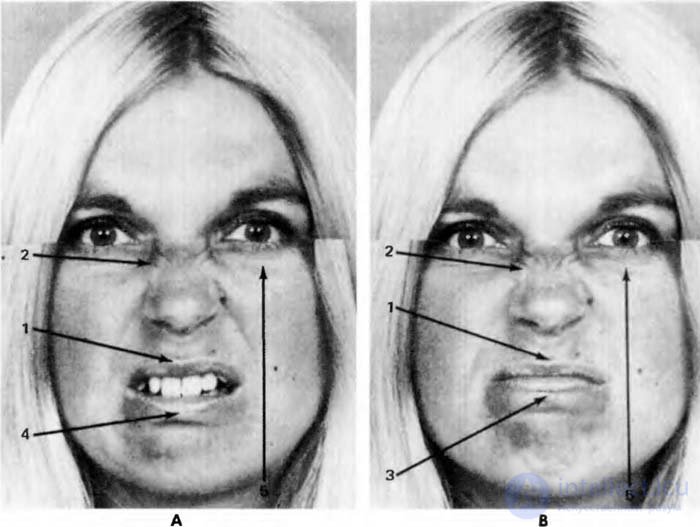
Picture 1 In fig. 1 Patricia shows that, in the event of a disgust, her upper lip is raised (1), which leads to a change in the appearance of the tip of the nose. The raised upper lip may or may not be supplemented by deformation of the wings of the nose and wrinkling on the bridge of the nose (2). The greater the aversion, the higher the likelihood that the wrinkling of the nose will also become noticeable. The lower lip can be raised and slightly pushed forward (3) or lowered and slightly pushed forward (4). The cheeks are raised, which causes a change in the appearance of the lower eyelids, narrowing of the opened eyes and the appearance under the eyes of numerous folds and wrinkles (5). Although on the face expressing disgust, eyebrows are usually lowered, this detail is insignificant. In fig. 1 Patricia looks disgusted even though her eyebrows and lower eyelids are copied from a neutral photo. Compare pic. 1 with fig. 2, where the eyebrows are lowered down, and you will see that the expression of disgust seems more complete and somewhat stronger, but the difference between fig. 1 and fig. 2 is not too large.
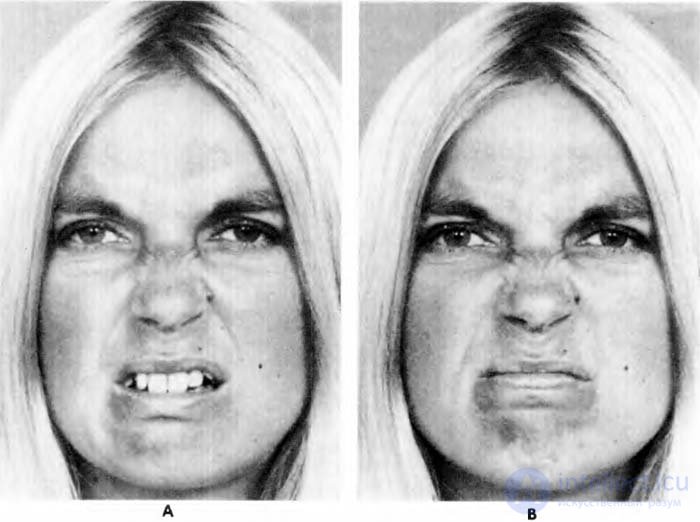
Figure 2 The condition of the face shown in fig. 2, can occur when a person is not really disgusted, but uses an emblem of emotion, meaning something unpleasant. For example, if Patricia had said, “When I dined at this restaurant last week, I saw a cockroach,” at the same time she could show one of the emblems of the emotion of disgust. But she would use her face in such a way that it would become clear to others that now she does not feel any disgust. She could wrinkle her nose quickly and slightly raise her cheeks and upper lip, or simply lift her upper lip without wrinkling her nose. There are two indications that here we are dealing with emblems of emotion, and not with expressions of emotion on the face. First, Patricia is not disgusted at the moment, and, secondly, she does not want those who look at her to think that she is experiencing him. Here there is only a partial involvement of the elements of the face: either a wrinkled nose - raised cheeks - a slightly raised lip, or a raised lip - not a wrinkled nose, and perhaps neither. In addition, this expression persists for a short moment, rather than a few seconds. For the expression of a feigned disgust, the whole face can be fully involved (Fig. 2), but such an expression will have to be maintained for a long time - while Patricia plays her feigned disgust.
Some people use, though not always, either a wrinkled nose, or a slightly raised upper lip as a colloquial “punctuation mark” to focus attention on a word or sentence. We have already noted that in other cases, quickly raised surprised eyebrows or quickly open surprised eyelids are used as colloquial “punctuation marks”. Later we will see that lowered, angry flattened eyebrows and flattened, sadly raised eyebrows also often serve as colloquial “punctuation marks”. In both cases, the functions of the movement of the face resemble the functions of the movement of the hands while emphasizing the meaning of a word or phrase. We know little about why some people use their faces instead of hands or with their hands to place colloquial "punctuation marks" - We also know little about whether each such "mark" - surprised eyebrows, nose wrinkled with disgust, or sad eyebrows - some psychological sense. Such a “punctuation mark” may reflect some information about the peculiarities of a person’s personality, or be the result of his unintentional desire to imitate, for example, his father or mother coming from childhood when he was just learning to speak, or may be determined by the features of his neuroanatomy.
INTENSITY VARIATIONS
Aversion can vary in intensity - from mild to extreme. In case of a slight aversion, the nose frowns slightly, and the upper lip rises less noticeably than in fig. 2. With a stronger aversion and wrinkling of the nose, and raising the upper lip are more pronounced than shown in fig. 2. The crease between the nose and the lip and the wrinkles that go from the nostrils to the corners of the mouth can become deeper and more noticeable. In the event of utter disgust, the tongue can move forward and appear between the teeth or even lean out.
METHODS OF EXPRESSING DISORDERS
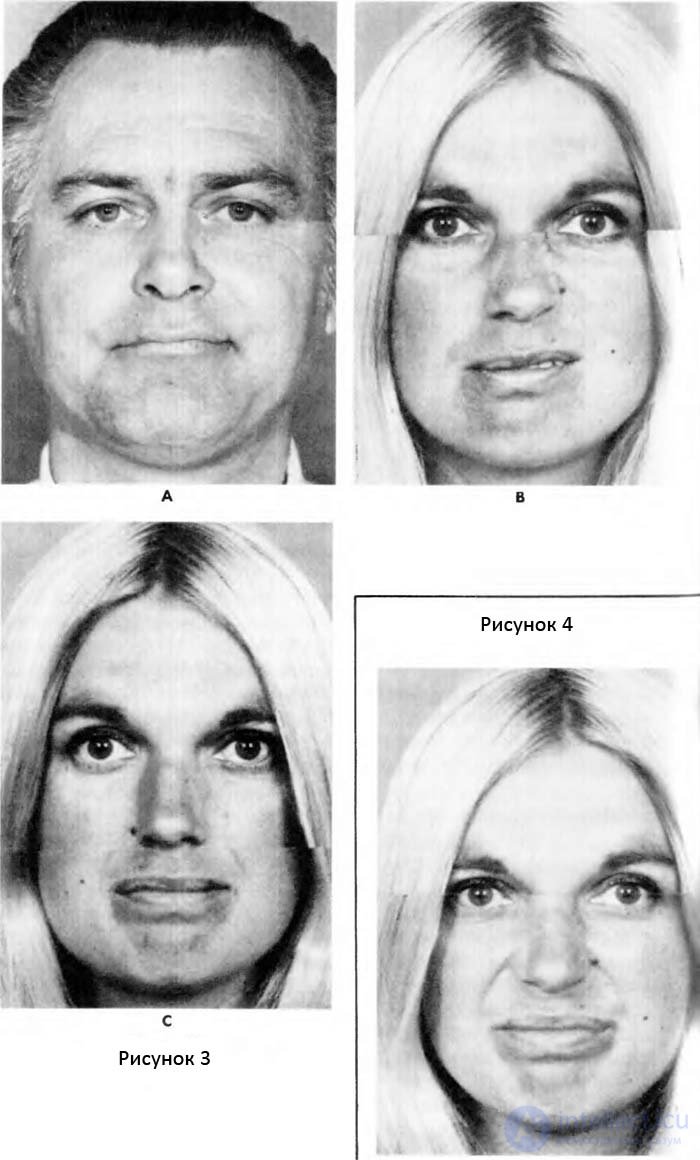
Contempt is manifested on the face by changing the position of the closed lips of the mouth expressing disgust. In fig. 3 shows three options for the expression of contempt. John shows an asymmetrical scornful mouth with slightly compressed lips and a raised left edge of the mouth. Patricia's facial expression in fig. 3B is basically the same as that of John, with the only difference that her upper lip, raised from one side, allows you to see her teeth. This adds a contemptuous, mocking touch to her expression. Patricia's face in pic. 3C, with a slightly raised upper lip, shows a softer form of contempt. Figure 4 shows the combination of the elements of contempt and disgust: contempt manifests itself in tightly compressed, slightly elevated corners of the mouth and tightly closed lips. This face is very similar to the face with the pic. 3A, except that the expression is symmetrical, not asymmetric: both corners of Patricia’s mouth are tightly compressed. The indication that in fig. 4 Patricia’s face is disgusted, with a slightly raised and raised lower lip and a slightly wrinkled nose. Compare this Patricia's face with her face in pic. 2b and you will see similarities.
MIXED EXPRESSIONS
Figure 5

Disgust can be combined with surprise. In fig. 5 shows a face expressing disgust in all three areas (5A), a surprised face (5B) and a face expressing a combination of disgust (Fig. 5A - lower part of the face, lower eyelids) and surprise (eyebrows - forehead, upper eyelids). Such an expression could arise if Patricia felt aversion to something unexpected for her, and the surprise had not yet completely disappeared from her face. Much more often the expression presented in fig. 5C is not actually an expression of a mixed feeling of disgust and surprise; such surprised brow raising should be added rather as a logo to underline the expression of disgust. You can imagine how in fig. 5A Patricia says something like “Ffuu”, while in the composite photo in fig. 5C she can say: “Oh my God, how disgusting!”
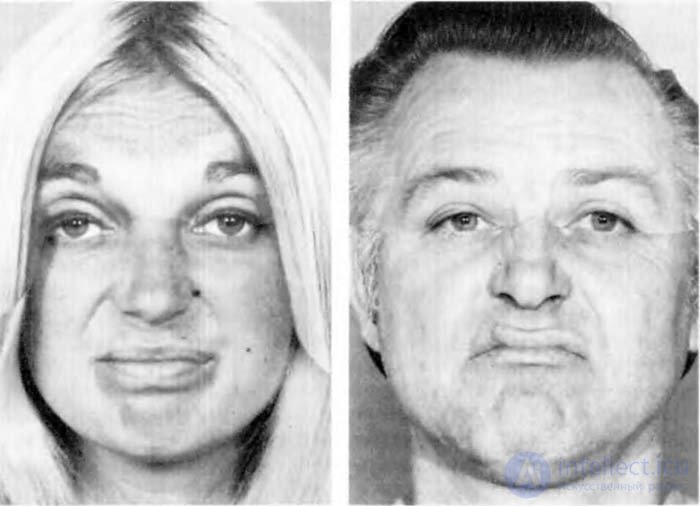
Figure 6 Elements of disgust and surprise are combined in another expression, which is not a simple sum of two messages, but creates a completely new message. In fig. 6 shows surprised eyebrows - forehead and lower part of the face expressing disgust and lower eyelids. Patricia also has lower eyelids slightly lowered, and her mouth expresses a combination of disdain and disgust (Fig. 4). The lower part of John’s face is disgusting - something we haven’t seen before, with his upper lip and cheeks raised, his nose slightly wrinkled, his lower lip slightly raised, pushed forward, and his eyebrows not lowered. This lower part of John’s face is a variation of the lower part of Patricia’s face, shown in fig. 1B. Both faces in pic. 6 express disbelief. Compare these faces with the face on the pic. 5B).
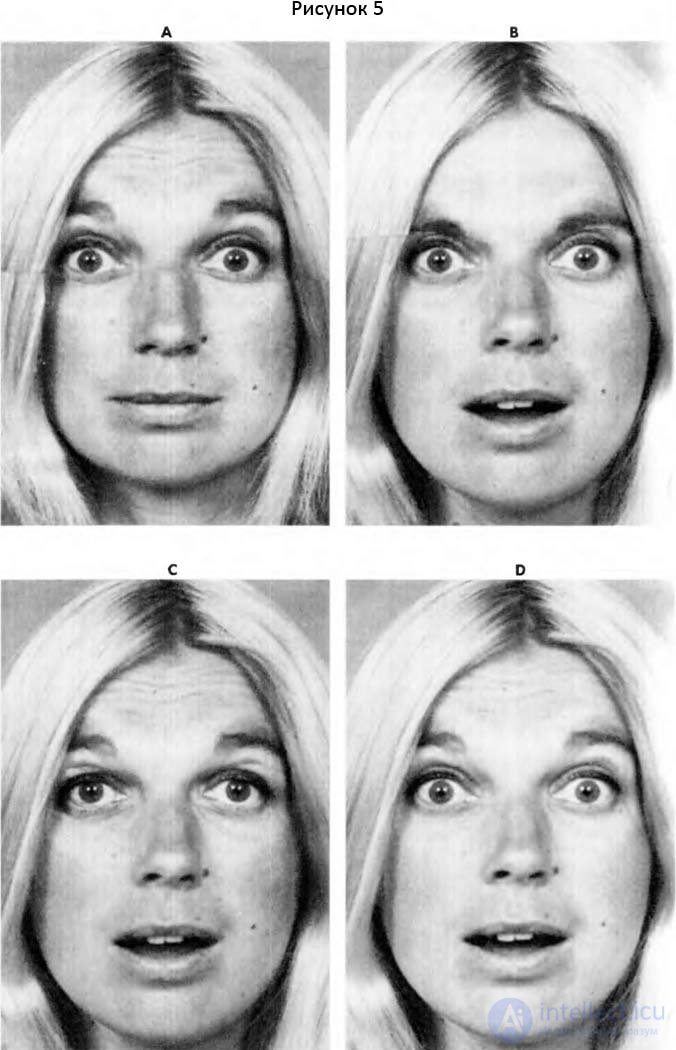
having surprised eyebrows on a neutral background; on the face of the displayed question. By adding an expressive mouth aversion, as is done in fig. 6, we observe mistrust and skepticism. Very often, such a facial expression is accompanied by swaying of the head from side to side.
Figure 7
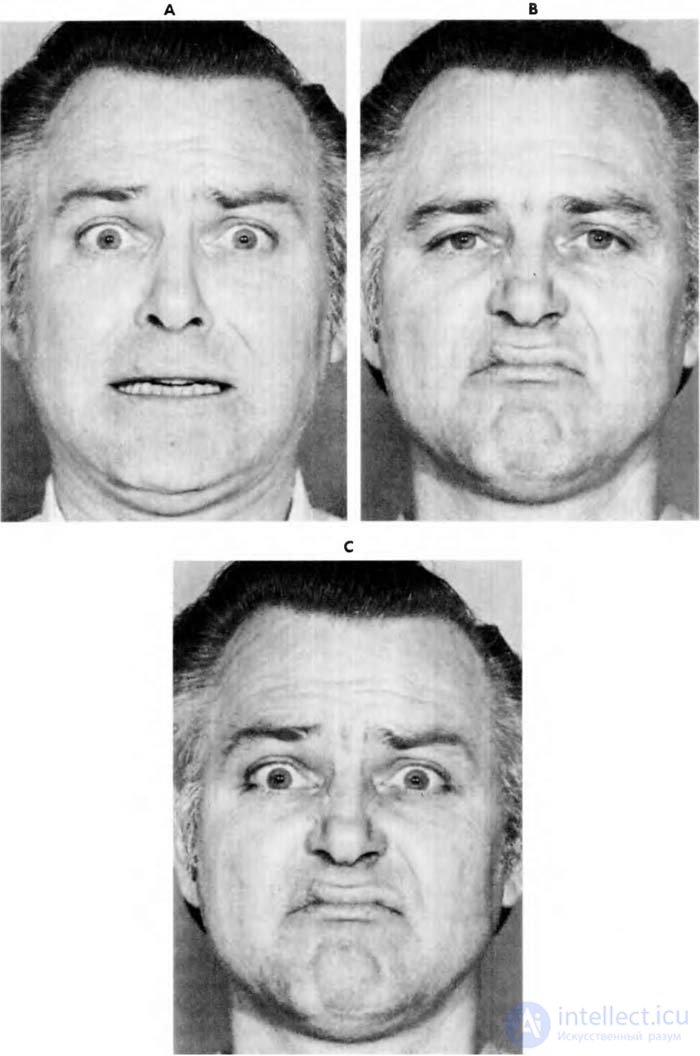
Disgust can be mixed with fear. In fig. 7 John shows fear (7A), disgust (7B) and a mixture of disgust (lower part of face - lower eyelids) and fear (7C) (eyebrows - forehead and upper eyelids). This mixed expression arises in the case of the threat of something disgusting.
Most often, disgust is mixed with anger. This combination will be shown below. Combinations of disgust and joy, aversion and sadness will be shown on the pages dedicated to these emotions.
SUMMARY
Disgust is mainly expressed by the lower part of the face and lower eyelids (Fig. 8).
Figure 8
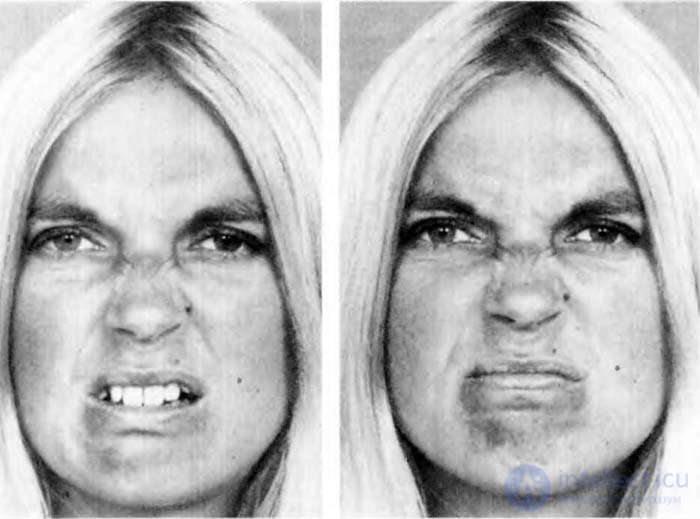
- Upper lip raised.
- The lower lip is also raised and moved to the upper lip or lowered and slightly pushed forward.
- The nose is wrinkled.
- Cheeks raised.
- Wrinkles appear on the skin under the lower eyelids, and the eyelids are raised, but not tense.
- Eyebrows lowered, resulting in lowering eyelids.
“CONSTRUCTION” OF PERSONAL EXPRESSIONS
For the emotion of disgust, you cannot create variations of facial expressions by replacing parts of the face with others, as you could for emotions of fear and wonder. The reason for this lies in the interconnectedness of muscular movements in different areas of the face in the expression of disgust. The muscles that lift the upper lip also lift the cheeks, pouches and skin folds under the eyelids. Therefore, the imposition of part B on the faces in Fig. 8 will create something that really cannot be tolerated by human anatomy. The eyes shown in parts B would not be able to look this way if the area of the mouth looked like in fig. eight.
Muscles involved in wrinkling the nose, also raise the cheeks, slightly raise the lower lip, pouches and skin folds under the lower eyelids. Therefore, the imposition of parts D on the face in Fig. 8 will create an expression impossible in terms of anatomy. If the nose were wrinkled, as shown in the figure, the upper eyelids would have to lift up, and the tip of the nose would have to change its configuration. Muscles, lowering eyebrows, also lower the upper eyelids, partially covering the eyes. Therefore, if you overlap parts A in fig. 8, something stupid will arise. The image will still have lowered eyelids even though you have removed lowered eyebrows.






 having surprised eyebrows on a neutral background; on the face of the displayed question. By adding an expressive mouth aversion, as is done in fig. 6, we observe mistrust and skepticism. Very often, such a facial expression is accompanied by swaying of the head from side to side.
having surprised eyebrows on a neutral background; on the face of the displayed question. By adding an expressive mouth aversion, as is done in fig. 6, we observe mistrust and skepticism. Very often, such a facial expression is accompanied by swaying of the head from side to side. 

Comments
To leave a comment
Psychology of emotions
Terms: Psychology of emotions